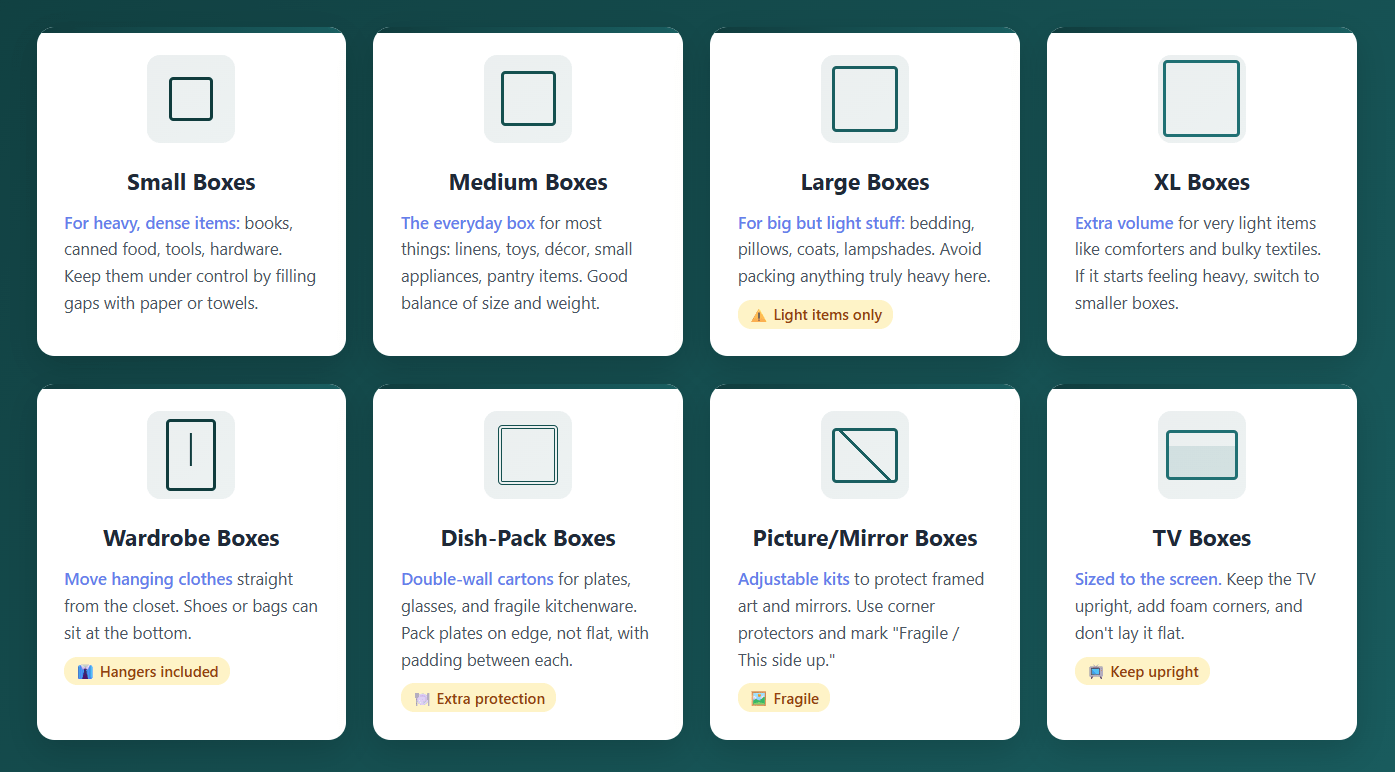
Moving Box Calculator
Plan smarter, pack faster. Use our free moving box calculator to estimate exactly how many small, medium, large, XL, wardrobe, dish-pack, and specialty boxes you’ll need—plus tape, paper, and wrap. Get tailored counts by home size, household, and lifestyle, then save or print a shareable checklist.
How Our Moving Box Calculator Works
Tell us a few basics, and we’ll translate your home and packing style into a clear shopping list.
- You enter the essentials. Home size (studio to 5+ bedrooms), how many people, and a couple of quick toggles (e.g., lots of fragile kitchenware or not).
- We estimate your box mix. The tool converts that info into a balanced set of small, medium, large, XL, wardrobe, and specialty boxes—so heavy things go in smaller cartons and light, bulky items go in larger ones.
- We fine-tune for your situation. If you mark “Stuff-heavy” or “Minimalist,” the counts shift up or down. Extra fragile items add dish-packs; more closets add wardrobe boxes.
- You get a complete checklist. Final box and packing material counts (tape, paper, wrap), and the option to save, print, or email the list.
That’s it—fast inputs, a decent mix of boxes, and an instant packing plan.
What Types of Moving Boxes Do You Need?
- Small boxes — For heavy, dense items: books, canned foods, tools, hardware. Line them up by stuffing gaps with paper or towels.
- Medium boxes — The standard box for general use of the majority of products: linens, toys, decorations, small household appliances, pantry items. Good size-to-weight proportion.
- Large boxes — For large but light items: bedding, pillows, coats, lampshades. Don’t put anything very heavy here.
- XL boxes — Extra volume for very light items like comforters and bulky textiles. If it starts feeling heavy, switch to smaller boxes.
- Wardrobe boxes — Move hanging clothes straight from the closet. Shoes or bags can sit at the bottom.
- Dish-pack boxes — Double-wall cartons for plates, glasses, and fragile kitchenware. Pack plates on edge, not flat, with padding between each.
- Picture/Mirror boxes — Adjustable kits to protect framed art and mirrors. Use corner protectors and mark “Fragile / This side up.”
- TV boxes — Sized to the screen. Keep the TV upright, add foam corners, and don’t lay it flat.

Moving Box Sizes: A Quick Guide
Not all boxes are created equal. Here’s a quick guide to the most common moving box types and what they’re best for. Capacities are typical and may vary by brand.
| Box type | Typical uses | Approx. capacity / notes |
|---|---|---|
| Small | Books, canned goods, tools, hardware | ~1.5 cu ft |
| Medium | Small appliances, toys, linens, pantry items | ~3.0 cu ft |
| Large | Bulky but light items (bedding, pillows) | ~4.5 cu ft |
| XL | Very light, high-volume textiles (comforters, duvets) | ~6.0 cu ft |
| Dish Pack (double-wall) | Plates, glassware, china, fragile kitchenware | ~5.2 cu ft |
| Wardrobe (with bar) | Hanging clothes; shoes/bags at the bottom | Capacity varies by box height/width |
| Picture/Mirror kit | Framed art, mirrors (adjustable panels) | Kit; size adjustable |
| TV box | Flat-screen TVs (packed upright with corner foam) | Match to TV diagonal |
Frequently Asked Questions?
What is a moving box?
A moving box is a durable corrugated box for household items. Stock sizes (small, medium, large, XL) are weight-friendly and nestable. Specialty types are available too: wardrobe, dish-pack, picture/mirror, and TV boxes.
What is the cheapest way to get moving boxes?
Try grocery, liquor, and book stores after restocking days. Try Freecycle and “free” postings on local groups. Inspect each box for tears, moisture, or insects; skip produce boxes if dirty or wet.
How many boxes do you need when moving a house?
Rule of thumb: Studio 15–25, 1-bedroom 25–35, 2-bedroom 40–60, 3-bedroom 60–80, 4-bedroom 80–100+. Actual depends on how much you have, how you pack, and breakables.
How to tape a moving box?
Use the H-tap e method: tape center seam at bottom, then the edge seams to form an “H.” Use a second strip on center seam for heavy loads. Close top flaps after packing and repeat.
Will the calculator tell me what size truck to rent?
Yes—after estimating total boxes, you’ll see a truck-size hint (e.g., small van/10′ for lighter loads up to ~50 boxes, scaling up through 26′ trucks). Treat this as guidance and confirm final capacity with your mover or rental company.
